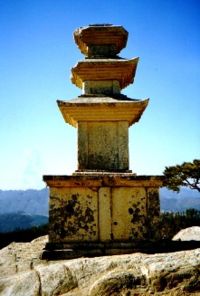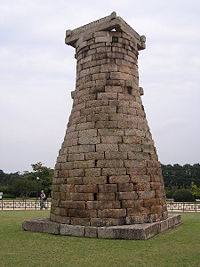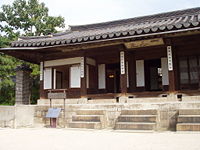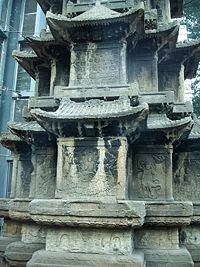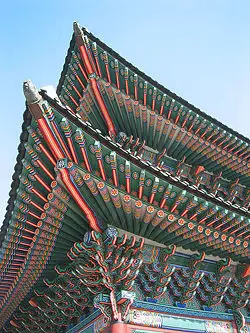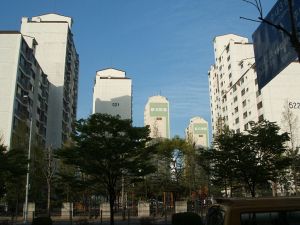Difference between revisions of "Korean architecture" - New World Encyclopedia
MaedaMartha (talk | contribs) |
MaedaMartha (talk | contribs) |
||
| Line 1: | Line 1: | ||
| − | '''Korean architecture''' refers to the [[architecture]] of [[Korea]]. | + | '''Korean architecture''' refers to the [[architecture]] of [[Korea]]. The early stages of Korean architecture date to the Neolithic period; [[Archaeology|archaeological]] evidence of [[ondol]], the unique Korean floor panel heating system, was found among the remains of the burnished plain pottery culture. Fro the first century B.C.E., Korean architecture was influenced by the Chinese. After the unification of the Korean peninsula into the kingdom of United Silla in the seventh century, the culture of the T'ang dynasty was absorbed and modified to create a unique Korean cultural identity. Buddhist art and architecture flourished, and great temples were built. The founding of the Joseon dynasty in 1392 introduced [[Neo-Confucianism|Neo-Confucian ideals]], which were expressed in architectural forms that emphasized veneration for ancestors and favored practicality, frugality, and harmony with nature. A consistent architectural style, graceful and elegant, appeared throughout Korean society. |
| − | + | Beginning with the Japanese occupation of Korea in 1910, through the ravages of [[World War II]] and the [[Korean War]], Korean architecture suffered and many architectural monuments were burned or destroyed. The practical needs of rebuilding after the war took precedence over aesthetics, and only since the 1988 [[Olympic games]] and the economic growth of the last two decades have Korean architects been able to evolve a unique modern architectural style. | |
| − | |||
| − | |||
| − | + | ==Ancient Architecture (Neolithic–7th century) == | |
| − | ==Ancient | ||
[[Image:Korea south silla pagoda.jpg|200px|thumb|right|A Silla pagoda.]] | [[Image:Korea south silla pagoda.jpg|200px|thumb|right|A Silla pagoda.]] | ||
| − | The | + | The early stages of Korean architecture date to the Neolithic period. [[Archaeology|Archaeological]] evidence of [[ondol]], the unique Korean floor panel heating system, was found among the remains of the burnished plain pottery culture, and the development of the vertical wall was evident in the primitive houses of this culture. |
| − | + | Two types of dolmens, the primitive tombs of important persons, have been found in the Korean peninsula. The southern type is low and often a simple slab without supporting stones; the northern type is larger and more definite in shape. The distribution of the dolmens implies a relation to the megalithic cultures of the Western world. | |
| − | During this period building techniques of houses evolved from | + | During this period, building techniques of houses evolved from pit dwelling to houses of earthen walls with thatched roofs, to log cabin construction, and finally, to a raised floor construction. |
In 109 B.C.E., the [[China|Chinese]] commandery at [[Nangnang]] (Lo-lang) was established in the northwest region of Korea. [[Chinese architecture]] strongly influenced Korean architecture at this time, creating a basis for further Korean development. | In 109 B.C.E., the [[China|Chinese]] commandery at [[Nangnang]] (Lo-lang) was established in the northwest region of Korea. [[Chinese architecture]] strongly influenced Korean architecture at this time, creating a basis for further Korean development. | ||
| − | After the fall of Nangnang in 313, [[Goguryeo]], one of the [[Three Kingdoms of Korea]], expanded her territory to included half of Manchuria and all of | + | After the fall of Nangnang in 313, [[Goguryeo]], one of the [[Three Kingdoms of Korea]], expanded her territory to included half of Manchuria and all of northern Korea. Two different types of tombs evolved during this period: one is a stepped pyramid made of stone, while the other is a large earth mound form. |
| + | |||
| + | Baekje was founded in [[18 B.C.E.]], and its territory included the west coast of the Korean peninusula. Paekche established friendships with China and Japan, and built temples. The earliest stone pagoda of the Miruk Temple in Iksan country is of particular interest, because it shows transitional features from a wooden pagoda to a stone one. The art and architecture of the Paekche period had a touch of elegance, refinement and warmth. Paekche assimilated diverse influences and expressed its derivation from Chinese models. Later, important elements of the architectural style of Paekche were adopted by Japan. | ||
| − | + | [[Silla]] was the last of the three kingdoms to develop into a full-fledged kingdom. Again many great temples were built, but the most famous architectural development is [[Cheomseongdae]], said to be the first stone observatory in Asia, built during the reign of [[Queen Seondeok of Silla|Queen Seondeok]] (632-646). The structure is famous for its unique and elegant form. | |
| − | [[Image:Cheomseongdae.jpg|left|thumb|200px|Cheomsongdae, ancient astronomical observatory built during the reign of Queen Seondeok.]] | + | [[Image:Cheomseongdae.jpg|left|thumb|200px|Cheomsongdae, ancient astronomical observatory built during the reign of Queen Seondeok.]] |
| − | ==United Silla | + | ==United Silla Architecture (7th–10th century) == |
[[Image:Iro-dang, Unhyeongung - Seoul, Korea.JPG|right|200px|thumb|Iro-dang]] | [[Image:Iro-dang, Unhyeongung - Seoul, Korea.JPG|right|200px|thumb|Iro-dang]] | ||
| − | After the unification of the Korean peninsula into the kingdom of United Silla, Korean institutions were radically transformed. United Silla absorbed the fully matured culture of the T'ang dynasty in China, and at the same time developed a unique cultural identity. New Buddhist sects were introduced from the T'ang and Buddhist art flourished. It was a | + | After the unification of the Korean peninsula into the kingdom of United Silla, Korean institutions were radically transformed. United Silla absorbed the fully matured culture of the T'ang dynasty in China, and at the same time developed a unique cultural identity of its own. New Buddhist sects were introduced from the T'ang, and Buddhist art flourished. It was a period of peace and cultural advancement in the arts, that displayed a new level of grace and elegance. |
| − | Architecture flourished in the royal capital of Kyongju, though almost all traces of the former glory have vanished | + | Architecture flourished in the royal capital of Kyongju, though almost all traces of the former glory have now vanished. The city was based around a fertile basin shaped by three mountains and two joining rivers. A gird network formed in the urban area, with the Hwangyong Temple at the center. |
| − | The plans of Korean | + | The plans of Korean Buddhist temples were characterized by two pagodas in front of the central main hall, in a symmetrical layout on the north-south axis with other buildings. [[Bulguksa|Pulguk Temple]], built on a stone platform at the foot hill of Mt. Toham near Kyongju, is the oldest existing temple in Korea. Its Tabo-tap, located to the right of the court, is unique in Korea and the rest of Asia. The temple was first founded early in the sixth century and was entirely rebuilt and enlarged in 752. |
| − | + | The rock cave shrine of Sokkuram, located on the crest of Mt. Toham was built around the same era, by the same master architect who built Pulguk Temple. This cave shrine was artificially and skillfully constructed with granite blocks, and covered with an earth mound on top to give the appearance of a natural landscape. The graceful statue of Buddha on a lotus pedestal in the center is the dominant feature of the chamber. Rock cave shrines are common in Asia, but few of these shrines and sculptures reveal such a high level of artistry. None are as religiously and artistically complete in overall design as those at Sokkuram | |
| − | |||
| − | Rock cave shrines are | ||
[[Image:Pagoda detail, Tapgol Park - Seoul, Korea.JPG|200px|thumb|Pagoda detail]] | [[Image:Pagoda detail, Tapgol Park - Seoul, Korea.JPG|200px|thumb|Pagoda detail]] | ||
| − | ==Goryeo | + | ==Goryeo Architecture (10th–14th century) == |
| − | Much of the architecture of this time was inspired by [[Buddhism]], such as magnificent [[Buddhist temple]]s and the [[Korean pagoda]]. Unfortunately, since most of the architecture of this time was built of wood, little has survived to the present day. Also, the capital of [[Goryeo]] was based in Gaesong, in modern day North Korea, which has made this era | + | Much of the architecture of this time was inspired by [[Buddhism]], such as magnificent [[Buddhist temple]]s and the [[Korean pagoda]]. Unfortunately, since most of the architecture of this time was built of wood, little has survived to the present day. Also, the capital of [[Goryeo]] was based in Gaesong, in modern-day North Korea, which has made it difficult for historians to study this era |
| − | ==Joseon architecture ( | + | ==Joseon architecture (14th–19th century) == |
[[Image:Korean architecture roof detail 2.jpg|thumb|250px|[[Joseon dynasty]] court architecture]] | [[Image:Korean architecture roof detail 2.jpg|thumb|250px|[[Joseon dynasty]] court architecture]] | ||
| − | The founding of the Joseon dynasty in 1392 brought to power like-minded men steeped in the doctrines of [[Neo-Confucianism]], which had slowly percolated into Korea from China | + | The founding of the Joseon dynasty in 1392 brought to power like-minded men steeped in the doctrines of [[Neo-Confucianism]], which had slowly percolated into Korea from China during the fourteenth century. This ushered in a new environment that was relatively hostile to Buddhism, causing the state to gradually shift its patronage from Buddhist temples to Confucian institutions. |
| − | Neo-Confucianism inspired new architectural paradigms. Jaesil, or clan memorial halls, became common in many villages where extended families erected facilities for common veneration of a distant ancestor. Jongryo, or memorial shrines, were established by the government to commemorate exceptional acts of filial piety or devotion. Even beyond these archetypes, the aesthetics of Neo-Confucianism, which favored practicality, frugality, and harmony with nature, forged a consistent architectural style throughout Korean society. | + | Neo-Confucianism inspired new architectural paradigms. Jaesil, or clan memorial halls, became common in many villages, where extended families erected facilities for common veneration of a distant ancestor. Jongryo, or memorial shrines, were established by the government to commemorate exceptional acts of filial piety or devotion. Even beyond these archetypes, the aesthetics of Neo-Confucianism, which favored practicality, frugality, and harmony with nature, forged a consistent architectural style throughout Korean society. |
| − | + | Confucian homes were designed with special attention to the position and role of each member of the household. The houses were usually arranged around one or more central courtyards, with separate living quarters for the men on the outside and the women on the inside. An ancestral hall or shrine dedicated to the family ancestors was located in a central or elevated place. Confucian temples consisted of two halls, one for study and one for the performance of ceremonial rites, and dormitories. If the temple was built on level ground, the ceremonial hall occupied the front position; on a slope it was located in the higher position to indicate its importance.<ref> http://www.orientalarchitecture.com Retrieved December 22, 2007</ref> | |
| − | |||
| − | Important architectural sites were destroyed, often by burning | + | ==Japanese Occupation Architecture (1910-1945)== |
| + | During the [[Korea under Japanese rule|Japanese occupation of Korea]], there was a systematic attempt by the [[Empire of Japan]] to destroy native Korean architecture and replace it with [[Japanese architecture]]. Important architectural sites were destroyed, often by burning, and significant elements of [[landscaping]], such as [[Korean gardens]], were razed. Traditional religious architecture was also discouraged. | ||
Japanese architecture was first introduced in the Korean transportation networks. [[Railroad]] lines saw the construction of Japanese-style [[rail station]]s and [[hotel]]s. [[Port]]s as transit points, however, had limited construction. Inland, the Japanese built new [[city hall]]s, [[barrack]]s and [[military base]]s, [[Prison|jail]] and [[prison]]s, [[police station]]s, and [[Koban (police box)|police box]]es. Korean architects were required to train only in Japan and encouraged to design exclusively along Japanese models when they returned. While the assumption was that Western influences on Japanese architects would have transferred to Korea, this did not happen. | Japanese architecture was first introduced in the Korean transportation networks. [[Railroad]] lines saw the construction of Japanese-style [[rail station]]s and [[hotel]]s. [[Port]]s as transit points, however, had limited construction. Inland, the Japanese built new [[city hall]]s, [[barrack]]s and [[military base]]s, [[Prison|jail]] and [[prison]]s, [[police station]]s, and [[Koban (police box)|police box]]es. Korean architects were required to train only in Japan and encouraged to design exclusively along Japanese models when they returned. While the assumption was that Western influences on Japanese architects would have transferred to Korea, this did not happen. | ||
| − | + | Building materials were in short supply, and much of the timber logged in Korea was sent to Japan. As a result, Korean buildings were left unrestored and neglected, contributing to the deterioration of much of Korean architectural history. Historic buildings were also decorated using Japanese ornamentation. | |
| − | ==Post-war | + | ==Post-war Period and Korean War Architecture== |
| − | After the unconditional surrender in 1945, American architecture assumed supremacy. Under [[Douglas MacArthur]], | + | After the unconditional surrender in 1945, American architecture assumed supremacy. Under [[Douglas MacArthur]], Korean architecture by Koreans was resumed in domestic areas, with extensive repair of the missionary churches being given priority funding. Essential repair to infrastructure followed, often patch-work reconstruction rather than new projects, and simple construction of block-built hospitals, schools, and industries began under military supervision. |
| − | Seoul had survived much of [[World War II]] but during the [[Korean War]] (1950-1953), many buildings were destroyed, with the city changing command between [[North Korea]]n and [[South Korea]]n powers five times. Important architectural sites were over-run and | + | Seoul had survived much of [[World War II]], but during the [[Korean War]] (1950-1953), many of its buildings were destroyed, with the city changing command between [[North Korea]]n and [[South Korea]]n powers five times. Important architectural sites were over-run and burned by invading [[People's Liberation Army]] forces, and the urban landscape suffered lack of financial resources for repairs. |
| − | == Modern | + | == Modern Architecture == |
| − | With the armistice, | + | With the armistice, distinct architectural styles determined by foreign governments began a long period of development. In the north, Stalinist and absolutist, often brutalist architecture, was championed. North Korean architects studied in [[Moscow]] or Soviet satellites, and brought back socialist worker styles and huge celebratory people's architecture on a grand and massively impressive scale. Nearly all architecture was government sponsored, and maintained great homogeneity of function and style. |
| − | + | In the south, the pragmatic need to rebuild a country devastated by genocide, then a civil war, led to buildings of no particular style, that were executed repetitively, and a factory system which produced simple, cheap, expendable buildings. Little attention was given to an architectural aesthetic. It was fortunate that most of this took place in the urban areas. | |
| − | |||
| − | In the south, | ||
[[Image:Bundang apartment buildings.JPG|thumb|Apartment buildings in [[Seongnam]] city, South Korea]] | [[Image:Bundang apartment buildings.JPG|thumb|Apartment buildings in [[Seongnam]] city, South Korea]] | ||
| − | |||
==Sports architecture== | ==Sports architecture== | ||
| − | + | New waves of new building activity were initiated when South Korea won the contract to host the [[1986 Asian Games]] and the [[1988 Summer Olympics|1988 Olympic games]]. To market the country globally, international architects were encouraged to submit designs for the sports complexes and accommodation facilities, introducing alternative concepts for modern architecture that began to put style and form ahead of spartan practicality. Historically, sports architecture has received the most funding and the attention as an expression of identity within Korea. Hundreds of billions of won have been spent on defining Korea as a sports mecca, with architecture leading the way. | |
| − | |||
| − | |||
| − | South Korea won the [[1986 Asian Games]] and the [[1988 Summer Olympics|1988 Olympic games]] | ||
| − | |||
| − | Important architects at this time | + | Important architects at this time, often led by the atelier-style architectural co-operative [[Space Group of Korea]] were: |
* [[Park Kil-ryong]] | * [[Park Kil-ryong]] | ||
| Line 84: | Line 74: | ||
* [[Gyusung Woo]] - Olympic Village, 1984. | * [[Gyusung Woo]] - Olympic Village, 1984. | ||
| − | It | + | It was not until the late 1980s and early [[1990s]] that an entirely new generation of Korean architects had the freedom and the financing to build Korean architecture in a distinct Korean manner. As a result of studying and training in Europe, Canada, and even in South America, Korean architects saw the need for a more unique style, and more use of sophisticated materials. There was a new determination that nationalistic architectural elements had to be revived and refined, and that buildings should have a meaning within their cultural context. |
| − | |||
| − | There was a new determination that nationalistic architectural elements had to be revived and refined | ||
| − | ==Post-modern Korean | + | ==Post-modern Korean Architecture (1986–2005)== |
| − | + | Individuality and experimentation became the new cause for young architects; however, the country as a whole was slow to move from the old traditions and to value good architectural aesthetics as important to the sense of a village, town, or city. At times, change was forcefully brought about in the face of intense resistance, and new buildings evolved at a substantial personal cost to the architects and builders, and under a great deal of tension. | |
| − | + | Cultural and museum buildings have followed; city halls and buildings for the civil service appear generally in a New York or Chicago style, rather than following London or Paris trends. Much of the growth of new architecture came from retail stores, clothing shops, bistros, and cafes. Foreign corporations setting up Korean headquarters also brought in an entirely new spirit of architecture to define their own visions. | |
| − | |||
| − | Much of the growth of new architecture came from retail stores, clothing shops, bistros, cafes. Foreign corporations setting up Korean headquarters also brought in an entirely new spirit of architecture to define their own visions. | ||
Important architects at this time include: | Important architects at this time include: | ||
| Line 101: | Line 87: | ||
* [[Kim Seok-Chul]] - [[Seoul Arts Centre]] | * [[Kim Seok-Chul]] - [[Seoul Arts Centre]] | ||
* Korean Architects Collaborative International under the guidance of Fentress Bradburn Architects - [[Incheon International Airport]] | * Korean Architects Collaborative International under the guidance of Fentress Bradburn Architects - [[Incheon International Airport]] | ||
| + | |||
| + | ==Notes== | ||
| + | <references/> | ||
| + | |||
| + | ==References== | ||
| + | *Bongryol, Kim, Lee Yongsuk, and E. Inmi. 2005. ''The secret spirit of Korean architecture.'' London, UK: Saffron Books. ISBN:1872843824 9781872843827 1872843832 9781872843834 | ||
| + | * Chin, Hong-sŏp. 1993. ''Cultural treasures of Korea'' [compilers, Chin Hong-sop ... et al.]. Elizabeth, N.J.: Hollym International Corp. ISBN:1565911008 9781565911000 | ||
| + | * CHOI, H.-V. (2002). ''Hanvit the beauty of Korean architecture'' : photographs. Seoul, Korea, Kwanhoon. ISBN:8995164522 9788995164525 | ||
| + | *Kim, Wŏn, and Eung-Sik Limb. 1983. ''Korean architecture''. Seoul: Kwangjang Pr. | ||
| + | * Korean architecture. 1959. Pyongyang, D.P.R.K.: Foreign Languages Pub. House. | ||
| + | * Lee, Sang-Leem. 2006. ''Space + house''. Seoul, Korea: Space Pub. 8985127187 9788985127189 | ||
| + | * Park, Sam Y. 1991. ''An introduction to Korean architecture.'' Seoul, Korea: Jungwoo Sa Pub. Co. | ||
{{Asia in topic|Architecture of}} | {{Asia in topic|Architecture of}} | ||
| Line 114: | Line 112: | ||
* [http://english.ohmynews.com/articleview/article_view.asp?article_class=2&no=219633&rel_no=1 Silla Architecture] | * [http://english.ohmynews.com/articleview/article_view.asp?article_class=2&no=219633&rel_no=1 Silla Architecture] | ||
* [http://www.architecture-trend-press.net/Data/_archi/Print.php?time=1093869443&year=2004-2005 Yi Jongho's atelier designs] | * [http://www.architecture-trend-press.net/Data/_archi/Print.php?time=1093869443&year=2004-2005 Yi Jongho's atelier designs] | ||
| + | [[Category:Korean art|Architecture]] | ||
| + | |||
[[Category:Korean art|Architecture]] | [[Category:Korean art|Architecture]] | ||
Revision as of 16:58, 22 December 2007
Korean architecture refers to the architecture of Korea. The early stages of Korean architecture date to the Neolithic period; archaeological evidence of ondol, the unique Korean floor panel heating system, was found among the remains of the burnished plain pottery culture. Fro the first century B.C.E., Korean architecture was influenced by the Chinese. After the unification of the Korean peninsula into the kingdom of United Silla in the seventh century, the culture of the T'ang dynasty was absorbed and modified to create a unique Korean cultural identity. Buddhist art and architecture flourished, and great temples were built. The founding of the Joseon dynasty in 1392 introduced Neo-Confucian ideals, which were expressed in architectural forms that emphasized veneration for ancestors and favored practicality, frugality, and harmony with nature. A consistent architectural style, graceful and elegant, appeared throughout Korean society.
Beginning with the Japanese occupation of Korea in 1910, through the ravages of World War II and the Korean War, Korean architecture suffered and many architectural monuments were burned or destroyed. The practical needs of rebuilding after the war took precedence over aesthetics, and only since the 1988 Olympic games and the economic growth of the last two decades have Korean architects been able to evolve a unique modern architectural style.
Ancient Architecture (Neolithic–7th century)
The early stages of Korean architecture date to the Neolithic period. Archaeological evidence of ondol, the unique Korean floor panel heating system, was found among the remains of the burnished plain pottery culture, and the development of the vertical wall was evident in the primitive houses of this culture.
Two types of dolmens, the primitive tombs of important persons, have been found in the Korean peninsula. The southern type is low and often a simple slab without supporting stones; the northern type is larger and more definite in shape. The distribution of the dolmens implies a relation to the megalithic cultures of the Western world.
During this period, building techniques of houses evolved from pit dwelling to houses of earthen walls with thatched roofs, to log cabin construction, and finally, to a raised floor construction.
In 109 B.C.E., the Chinese commandery at Nangnang (Lo-lang) was established in the northwest region of Korea. Chinese architecture strongly influenced Korean architecture at this time, creating a basis for further Korean development.
After the fall of Nangnang in 313, Goguryeo, one of the Three Kingdoms of Korea, expanded her territory to included half of Manchuria and all of northern Korea. Two different types of tombs evolved during this period: one is a stepped pyramid made of stone, while the other is a large earth mound form.
Baekje was founded in 18 B.C.E., and its territory included the west coast of the Korean peninusula. Paekche established friendships with China and Japan, and built temples. The earliest stone pagoda of the Miruk Temple in Iksan country is of particular interest, because it shows transitional features from a wooden pagoda to a stone one. The art and architecture of the Paekche period had a touch of elegance, refinement and warmth. Paekche assimilated diverse influences and expressed its derivation from Chinese models. Later, important elements of the architectural style of Paekche were adopted by Japan.
Silla was the last of the three kingdoms to develop into a full-fledged kingdom. Again many great temples were built, but the most famous architectural development is Cheomseongdae, said to be the first stone observatory in Asia, built during the reign of Queen Seondeok (632-646). The structure is famous for its unique and elegant form.
United Silla Architecture (7th–10th century)
After the unification of the Korean peninsula into the kingdom of United Silla, Korean institutions were radically transformed. United Silla absorbed the fully matured culture of the T'ang dynasty in China, and at the same time developed a unique cultural identity of its own. New Buddhist sects were introduced from the T'ang, and Buddhist art flourished. It was a period of peace and cultural advancement in the arts, that displayed a new level of grace and elegance.
Architecture flourished in the royal capital of Kyongju, though almost all traces of the former glory have now vanished. The city was based around a fertile basin shaped by three mountains and two joining rivers. A gird network formed in the urban area, with the Hwangyong Temple at the center.
The plans of Korean Buddhist temples were characterized by two pagodas in front of the central main hall, in a symmetrical layout on the north-south axis with other buildings. Pulguk Temple, built on a stone platform at the foot hill of Mt. Toham near Kyongju, is the oldest existing temple in Korea. Its Tabo-tap, located to the right of the court, is unique in Korea and the rest of Asia. The temple was first founded early in the sixth century and was entirely rebuilt and enlarged in 752.
The rock cave shrine of Sokkuram, located on the crest of Mt. Toham was built around the same era, by the same master architect who built Pulguk Temple. This cave shrine was artificially and skillfully constructed with granite blocks, and covered with an earth mound on top to give the appearance of a natural landscape. The graceful statue of Buddha on a lotus pedestal in the center is the dominant feature of the chamber. Rock cave shrines are common in Asia, but few of these shrines and sculptures reveal such a high level of artistry. None are as religiously and artistically complete in overall design as those at Sokkuram
Goryeo Architecture (10th–14th century)
Much of the architecture of this time was inspired by Buddhism, such as magnificent Buddhist temples and the Korean pagoda. Unfortunately, since most of the architecture of this time was built of wood, little has survived to the present day. Also, the capital of Goryeo was based in Gaesong, in modern-day North Korea, which has made it difficult for historians to study this era
Joseon architecture (14th–19th century)
The founding of the Joseon dynasty in 1392 brought to power like-minded men steeped in the doctrines of Neo-Confucianism, which had slowly percolated into Korea from China during the fourteenth century. This ushered in a new environment that was relatively hostile to Buddhism, causing the state to gradually shift its patronage from Buddhist temples to Confucian institutions.
Neo-Confucianism inspired new architectural paradigms. Jaesil, or clan memorial halls, became common in many villages, where extended families erected facilities for common veneration of a distant ancestor. Jongryo, or memorial shrines, were established by the government to commemorate exceptional acts of filial piety or devotion. Even beyond these archetypes, the aesthetics of Neo-Confucianism, which favored practicality, frugality, and harmony with nature, forged a consistent architectural style throughout Korean society.
Confucian homes were designed with special attention to the position and role of each member of the household. The houses were usually arranged around one or more central courtyards, with separate living quarters for the men on the outside and the women on the inside. An ancestral hall or shrine dedicated to the family ancestors was located in a central or elevated place. Confucian temples consisted of two halls, one for study and one for the performance of ceremonial rites, and dormitories. If the temple was built on level ground, the ceremonial hall occupied the front position; on a slope it was located in the higher position to indicate its importance.[1]
Japanese Occupation Architecture (1910-1945)
During the Japanese occupation of Korea, there was a systematic attempt by the Empire of Japan to destroy native Korean architecture and replace it with Japanese architecture. Important architectural sites were destroyed, often by burning, and significant elements of landscaping, such as Korean gardens, were razed. Traditional religious architecture was also discouraged.
Japanese architecture was first introduced in the Korean transportation networks. Railroad lines saw the construction of Japanese-style rail stations and hotels. Ports as transit points, however, had limited construction. Inland, the Japanese built new city halls, barracks and military bases, jail and prisons, police stations, and police boxes. Korean architects were required to train only in Japan and encouraged to design exclusively along Japanese models when they returned. While the assumption was that Western influences on Japanese architects would have transferred to Korea, this did not happen.
Building materials were in short supply, and much of the timber logged in Korea was sent to Japan. As a result, Korean buildings were left unrestored and neglected, contributing to the deterioration of much of Korean architectural history. Historic buildings were also decorated using Japanese ornamentation.
Post-war Period and Korean War Architecture
After the unconditional surrender in 1945, American architecture assumed supremacy. Under Douglas MacArthur, Korean architecture by Koreans was resumed in domestic areas, with extensive repair of the missionary churches being given priority funding. Essential repair to infrastructure followed, often patch-work reconstruction rather than new projects, and simple construction of block-built hospitals, schools, and industries began under military supervision.
Seoul had survived much of World War II, but during the Korean War (1950-1953), many of its buildings were destroyed, with the city changing command between North Korean and South Korean powers five times. Important architectural sites were over-run and burned by invading People's Liberation Army forces, and the urban landscape suffered lack of financial resources for repairs.
Modern Architecture
With the armistice, distinct architectural styles determined by foreign governments began a long period of development. In the north, Stalinist and absolutist, often brutalist architecture, was championed. North Korean architects studied in Moscow or Soviet satellites, and brought back socialist worker styles and huge celebratory people's architecture on a grand and massively impressive scale. Nearly all architecture was government sponsored, and maintained great homogeneity of function and style.
In the south, the pragmatic need to rebuild a country devastated by genocide, then a civil war, led to buildings of no particular style, that were executed repetitively, and a factory system which produced simple, cheap, expendable buildings. Little attention was given to an architectural aesthetic. It was fortunate that most of this took place in the urban areas.
Sports architecture
New waves of new building activity were initiated when South Korea won the contract to host the 1986 Asian Games and the 1988 Olympic games. To market the country globally, international architects were encouraged to submit designs for the sports complexes and accommodation facilities, introducing alternative concepts for modern architecture that began to put style and form ahead of spartan practicality. Historically, sports architecture has received the most funding and the attention as an expression of identity within Korea. Hundreds of billions of won have been spent on defining Korea as a sports mecca, with architecture leading the way.
Important architects at this time, often led by the atelier-style architectural co-operative Space Group of Korea were:
- Park Kil-ryong
- Jungup Kim or Kim Chung-up - Trained in France and designed the Olympic Memorial Gate/World Peace Gate, 1988.
- Jongseong Kim - Weight Lifting Gymnasium, Olympic Park, 1986.
- Kim Su-keun who trained in Tokyo - Olympic Stadium. 1984. Total area is 133,649metres³, 100,000seats, 245×180m diameter, 830m in perimeter.
- Gyusung Woo - Olympic Village, 1984.
It was not until the late 1980s and early 1990s that an entirely new generation of Korean architects had the freedom and the financing to build Korean architecture in a distinct Korean manner. As a result of studying and training in Europe, Canada, and even in South America, Korean architects saw the need for a more unique style, and more use of sophisticated materials. There was a new determination that nationalistic architectural elements had to be revived and refined, and that buildings should have a meaning within their cultural context.
Post-modern Korean Architecture (1986–2005)
Individuality and experimentation became the new cause for young architects; however, the country as a whole was slow to move from the old traditions and to value good architectural aesthetics as important to the sense of a village, town, or city. At times, change was forcefully brought about in the face of intense resistance, and new buildings evolved at a substantial personal cost to the architects and builders, and under a great deal of tension.
Cultural and museum buildings have followed; city halls and buildings for the civil service appear generally in a New York or Chicago style, rather than following London or Paris trends. Much of the growth of new architecture came from retail stores, clothing shops, bistros, and cafes. Foreign corporations setting up Korean headquarters also brought in an entirely new spirit of architecture to define their own visions.
Important architects at this time include:
- Um Tok-mun - Sejong Cultural Centre
- Kim Seok-Chul - Seoul Arts Centre
- Korean Architects Collaborative International under the guidance of Fentress Bradburn Architects - Incheon International Airport
Notes
- ↑ http://www.orientalarchitecture.com Retrieved December 22, 2007
ReferencesISBN links support NWE through referral fees
- Bongryol, Kim, Lee Yongsuk, and E. Inmi. 2005. The secret spirit of Korean architecture. London, UK: Saffron Books. ISBN:1872843824 9781872843827 1872843832 9781872843834
- Chin, Hong-sŏp. 1993. Cultural treasures of Korea [compilers, Chin Hong-sop ... et al.]. Elizabeth, N.J.: Hollym International Corp. ISBN:1565911008 9781565911000
- CHOI, H.-V. (2002). Hanvit the beauty of Korean architecture : photographs. Seoul, Korea, Kwanhoon. ISBN:8995164522 9788995164525
- Kim, Wŏn, and Eung-Sik Limb. 1983. Korean architecture. Seoul: Kwangjang Pr.
- Korean architecture. 1959. Pyongyang, D.P.R.K.: Foreign Languages Pub. House.
- Lee, Sang-Leem. 2006. Space + house. Seoul, Korea: Space Pub. 8985127187 9788985127189
- Park, Sam Y. 1991. An introduction to Korean architecture. Seoul, Korea: Jungwoo Sa Pub. Co.
| ||||||||
External links
- Asian Historical Architecture
- History of Korean architecture by Shin Young-hoon
- A Brief History of Korean Architecture
- ENHR Conference report by Jun, N.I., Hong, H.O. and Professor Yang on Japan's occupation architecture in Korea
- Junglim, a leading edge architectural atelier
- Visuals and plans of Junglim's larger projects
- Korean contemporary building, cityscapes shown to indicate changes
- Silla Architecture
- Yi Jongho's atelier designs
